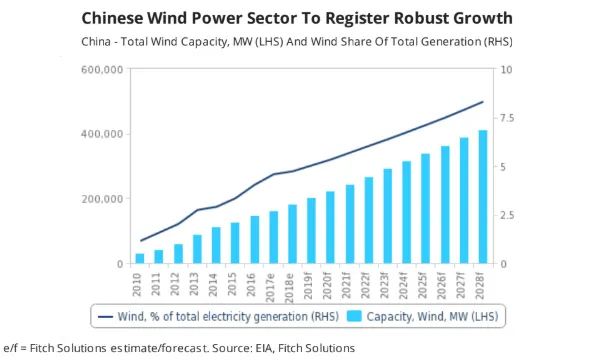
What's next for China's post-subsidy wind sector?
High wind curtailment rates could cushion the effect of a subsidy-free regime.
Even if the subsidies for China’s wind power sector will be phased out by 2021, it is expected to register robust growth over the coming decade thanks to the rapid improvements registered in reducing wind generation curtailment over the last two years, Fitch Solutions said in a note.
Curtailment has led to outstanding feed-in-tariff payments to renewables projects totalling more than $18b - a result of renewables power generated not being purchased as per the country's 2010 renewable energy law.
“As such, reducing curtailment and therefore giving access to the grid for renewables projects improves the scope that unsubsidised wind projects will be able to monetise all the electricity they generate - a precondition for their economic viability,” said Fitch Solutions.
Fitch Solutions explained that grid bottlenecks have raised renewables generation curtailment rates. “Crucially, as the Chinese renewables market grew from 15GW as of end-2008 to more than 370GW as of end-2018, transmission investment failed to keep pace,” it added.
“In particular, this led to substantial grid bottlenecks in key inland provinces - where good natural conditions for renewables technology led to substantial project development, but local demand for power is subdued. In 2016, wind power generation curtailment in the Gansu, Xinjiang and Inner Mongolia were as high as 43%, 38% and 31% of the total in each province respectively. Notably, the three provinces also comprised almost 40% of the total installed wind power capacity in China that year with their cumulative 56,100MW. As such, China's national wind generation curtailment rate totalled 17.1% over 2016,” Fitch Solutions said.
Over the next five years, more reductions in grid bottlenecks are expected. “A key component of such efforts has been to deploy a plethora of ultra-high-voltage (UHV) transmission lines that connect surplus power generation provinces (often inland) with power consumption hub provinces (often coastal). This has enabled inland provinces to integrate more renewable energy to the grid, and we expect wind generation curtailment to register continued reductions over the coming years,” Fitch Solutions said.
As of 2018, total Chinese wind curtailment had been reduced to 7% of total generation, entailing a 10% drop from 2016. At the same time, Gansu, Xinjiang and Inner Mongolia faced curtailment rates of 19%, 23% and 10% respectively - substantially lower than 2016.
Whilst Xinjiang and Gansu were banned from China's first unified bidding round for solar power in 2019 due to continued curtailment, these regions are projected to become competitive for renewables investment as grid bottlenecks are reduced further. “Given their favourable natural conditions for wind power and land availability, we believe these provinces will be able to support cost deflation for wind technology to the extent it undercuts China's coal electricity benchmark tariffs, thus becoming subsidy-free,” said Fitch Solutions.













 Advertise
Advertise











